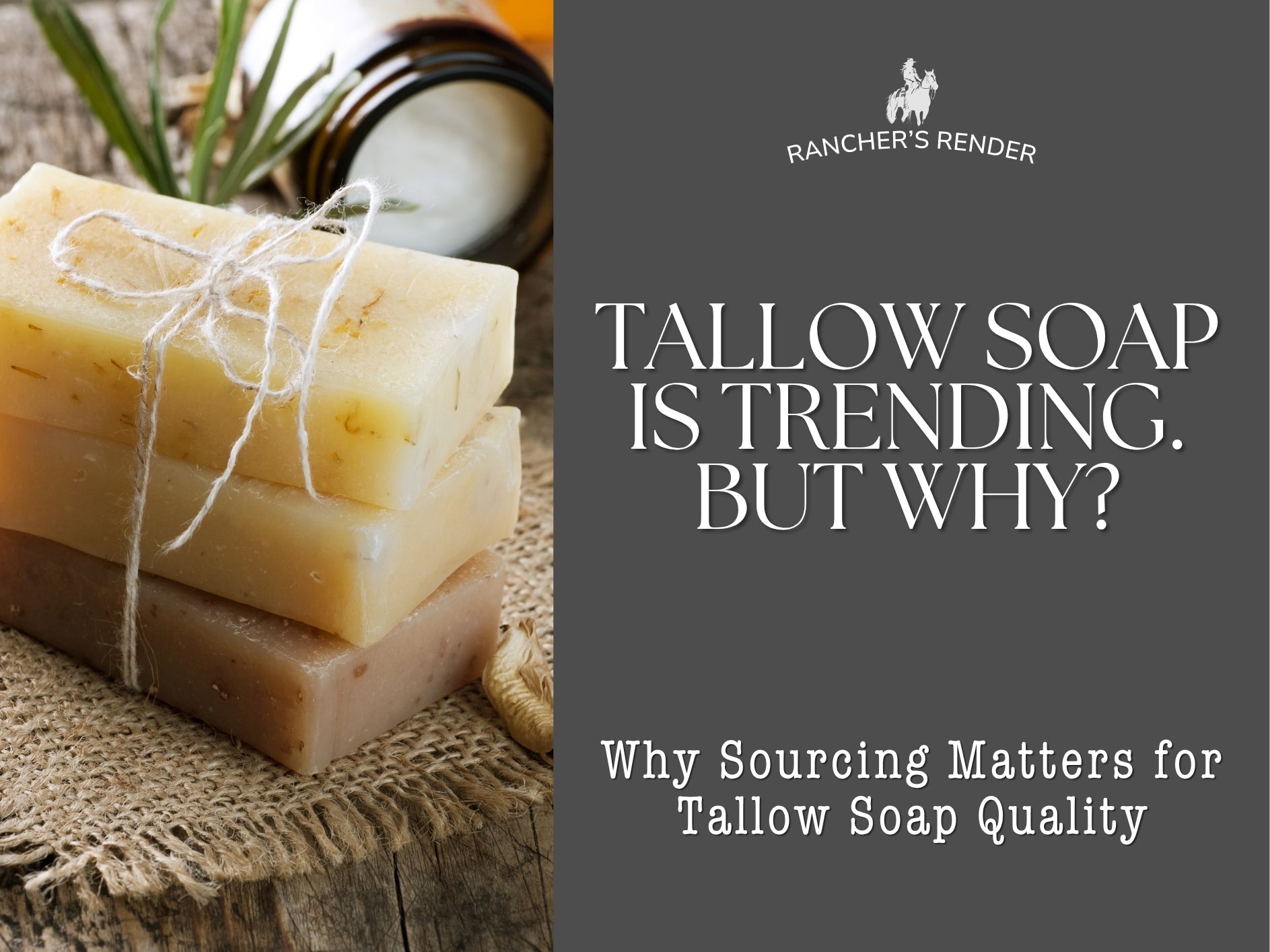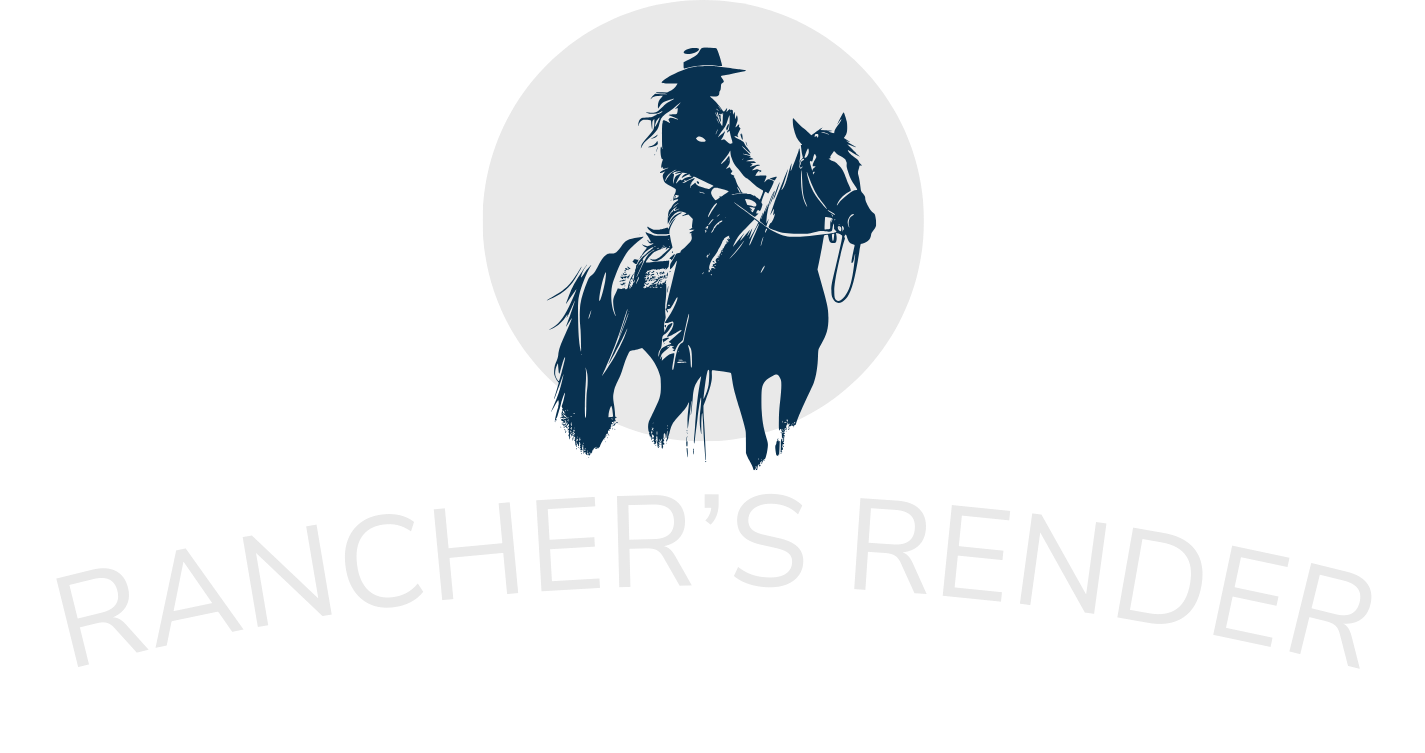
Why Beef Tallow Soap Is Making a Comeback
Get Ready: Our Grass-fed Tallow Soap is Launching Soon.
Here's what makes it different—and why the source of your tallow matters more than you think.
If you've been following our journey from rendering tallow for skincare to creating our whipped creams and balms, you know we're all about transparency. We raise the cattle, render the suet, and tell you exactly what goes into every jar.
Now we're expanding into something our customers have been asking about: beef tallow soap. Ours is coming soon - Sneak Peak below!
But here's the thing—not all tallow soap is created equal. The difference between a soap that leaves you smelling like a steakhouse and one that actually nourishes your skin comes down to one critical factor: the source of the tallow.
Want to understand our rendering process?
Discover how we transform suet into premium skincare →
What Exactly Is Beef Tallow Soap?
Let's start with the basics. Beef tallow soap is exactly what it sounds like—soap made from rendered beef fat combined with lye (sodium hydroxide) through a process called saponification. When these ingredients combine, they create something entirely new: a gentle, moisturizing cleanser that's been trusted for over 4,800 years.
Unlike modern detergent bars loaded with sulfates and synthetic ingredients, traditional tallow soap works with your skin's natural oils rather than stripping them away. The saponification process transforms the fats into soap molecules (sodium tallowate) plus natural glycerin—a humectant that draws moisture to your skin.
Here's what makes tallow soap special:
- Biocompatible fatty acids that match human sebum
- Natural glycerin retained from the saponification process
- Long-lasting bars that don't dissolve quickly
- Rich, stable lather without synthetic foaming agents
Recent research published in peer-reviewed journals confirms what traditional soap makers have long known: tallow's fatty acid profile (35-47% oleic acid, 25-30% palmitic acid, 15-25% stearic acid) closely mimics the protective oils naturally produced by human skin.
The Science Behind Superior Tallow Soap
Not all tallow creates equal soap. The science is clear: grass-fed beef suet produces dramatically different soap than ordinary trim fat—and the numbers prove it.
Learn the difference between suet and trim fat:
Find out why suet is the gold standard for tallow products →
Quality Indicators That Matter:
Saponification Value: Grass-fed suet consistently tests at 190-200 mg KOH/g, indicating optimal fatty acid content for soap making. Trim fat varies wildly, often testing below 185, resulting in softer, less stable bars.
Hardness Rating: Professional soap makers measure hardness on a scale of 0-100. Our suet-based formulation achieves 45-54—the sweet spot for a bar that lasts without being brittle. Trim fat soaps typically score 29-35, dissolving faster in your shower.
Cleansing vs. Conditioning Balance: The ideal soap cleanses effectively (12-22 range) while maintaining high conditioning properties (44-69 range). Suet naturally achieves this balance. Trim fat? Not so much.
But here's what really sets suet apart: the complete absence of myoglobin and connective tissue. These proteins, abundant in trim fat, are exactly what create that distinctive "beefy" smell when heated. Since pure suet contains virtually none of these compounds, the resulting soap is naturally odorless.
See how we ensure product safety:
Discover our rigorous water activity testing standards →
Who Benefits Most from Beef Tallow Soap?
After years of feedback from our tallow skincare customers, we've identified who sees the most dramatic results from tallow-based products:
Perfect for Dry, Mature, or Sensitive Skin
If you're dealing with chronically dry skin, eczema, or psoriasis, tallow soap offers something plant-based alternatives can't match. The fatty acid profile doesn't just clean—it actively supports your skin's barrier function. Clinical studies show participants with atopic dermatitis experienced significant symptom reduction within days of switching to tallow-based cleansers.
Women over 50 particularly love tallow soap. As natural sebum production declines with age, the biocompatible fats in tallow help compensate for what your skin no longer produces on its own.
Ideal for Minimalist Routines
Tired of 10-step skincare routines? Tallow soap simplifies everything. One bar can replace:
- Face wash
- Body wash
- Shaving soap
- Even shampoo (for those embracing the "no-poo" movement)
The natural glycerin content means you might not need a separate moisturizer—especially if you're already using our whipped tallow cream for extra-dry areas.
New to tallow soap?
Learn the right techniques for best results →
Not for Everyone
Let's be honest: tallow soap isn't ideal for:
- Very oily or acne-prone skin (comedogenic rating of 2-4)
- Those with alpha-gal syndrome (mammalian meat allergy)
- Strict vegans or vegetarians
That's okay. We believe in transparency, not trying to convert everyone to tallow everything.
What Makes Beef Tallow Soap Different from Plant-Based Alternatives
You'll find plenty of coconut oil soaps, olive oil soaps, and trendy "superfood" bars out there. So why choose tallow?
The Lather Factor: Tallow creates what soap makers call a "creamy, stable lather"—dense bubbles that don't disappear the moment they hit your skin. Coconut oil creates big, fluffy bubbles that look impressive but offer less actual cleansing power.
The Longevity Difference: A properly made tallow soap bar lasts 2-3 times longer than typical plant-based bars. The saturated fat content creates a harder bar that doesn't turn to mush in your shower. When you do the math, that "expensive" tallow soap often costs less per use than cheaper alternatives.
The Moisturizing Edge: While coconut oil soap can be drying (ironically), tallow soap maintains skin moisture. The difference? Tallow's fatty acid profile includes more conditioning fats and less of the short-chain fatty acids that strip natural oils.
The Sustainability Factor: Here's something the plant-based soap industry doesn't advertise: tallow soap uses a byproduct that would otherwise go to waste. No deforestation for palm oil. No water-intensive crop cultivation. Just smart use of existing agricultural resources.
Learn about our zero-waste philosophy:
See how we use every part of our grass-fed cattle →
Common Concerns About Tallow Soap (And the Truth)
Let's address the elephant in the room—or should we say, the cow in the shower?
"Won't I Smell Like Beef?"
Only if the soap maker used trim fat instead of suet. Our commitment to using only kidney suet from our grass-fed cattle means naturally odorless soap. No added fragrances needed to mask anything—though we'll offer both scented and unscented options.
Understand the suet difference:
Discover why our tallow products never smell "beefy" →
"Is It Sanitary?"
The saponification process creates an inherently antimicrobial product. Combined with proper shelf life management, tallow soap is actually more stable than many plant-based alternatives that require synthetic preservatives.
Learn about tallow shelf life:
Find out how long tallow products really last →
"Will It Clog My Drains?"
No more than any other soap. All true soaps leave some residue (that's what soap scum is), but tallow soap doesn't create any unique plumbing challenges. Regular cleaning keeps drains clear regardless of soap type.
"Is It Really Better Than Regular Soap?"
Define "regular." If you mean commercial detergent bars, absolutely. True soap maintains skin health rather than disrupting it. If you mean other handmade soaps, it depends on your skin's needs. We're not here to bash other natural soaps—just to explain why tallow offers unique benefits.
The Rancher's Render Difference: From Our Pasture to Your Shower
Here's what sets our upcoming tallow soap apart:
Single-Source Transparency: Every bar traces back to our 600-acre New Jersey ranch. We know which pastures the cattle grazed, what season the suet was harvested, and exactly how it was processed. Try getting that information from a commercial soap company.
USDA-Certified Processing: We don't make soap in our kitchen. Our professional rendering process ensures consistent quality and safety that meets commercial standards.
See our commitment to quality:
Discover why we don't do "kitchen cosmetics" →
Pure Suet, Not Trim Fat: This isn't about being fancy—it's about results. Using only kidney suet means naturally odorless, pure white soap that performs consistently.
Regenerative Agriculture: Every bar supports our rotational grazing system that rebuilds soil health while raising healthy cattle. Your skincare routine becomes part of a larger environmental solution.
What to Look for in Quality Beef Tallow Soap
Not all tallow soaps are created equal. Here's your quality checklist:
Color: Should be white to pale cream. Yellow or brown indicates oxidation or poor-quality tallow.
Texture: Smooth, uniform surface without cracks or separation. Sweating or soft spots suggest incomplete saponification.
Lather: Rich, creamy, and stable. Thin or quickly disappearing lather indicates formulation issues.
Longevity: A 4-5 oz bar should last 4-6 weeks with daily use. Rapid dissolution means too much coconut oil or insufficient cure time.
Ingredients: Look for simple formulations. "Sodium tallowate" should be the first ingredient. Avoid bars with long lists of synthetic additives.
Source Disclosure: Can the company tell you where their tallow comes from? Transparency matters.
When to Expect Our Beef Tallow Soap
We're putting the finishing touches on our formulations and running final stability tests. Our goal? To offer both unscented and naturally scented options that meet the same quality standards as our existing skincare line.
What we can promise:
- Pure grass-fed suet from our own cattle
- Professional cold-process manufacturing
- Proper 4-6 week cure time for optimal performance
- Simple, effective formulations without unnecessary additives
- The same radical transparency you've come to expect
Sign up for our newsletter to be the first to know when our beef tallow soap launches.

The Bottom Line on Beef Tallow Soap Benefits
Beef tallow soap offers scientifically proven benefits: superior moisturizing, longer-lasting bars, and compatibility with human skin biology. But only when it's made right, starting with quality suet rather than cheap trim fat.
Whether you're dealing with dry skin, seeking a minimalist routine, or simply want soap that actually nourishes while it cleanses, properly made tallow soap delivers. The key is finding producers who prioritize quality from pasture to product.
We're excited to bring you soap that meets our standards—and yours. Because at Rancher's Render, we believe skincare should be simple, effective, and honest.
Have questions about our upcoming tallow soap? Wondering how it compares to our whipped tallow cream or pure balm? Drop a comment below. We read and respond to every one.
Worried about clogged pores?
Why tallow soap beats balm for acne-prone skin →
Compare our product formats:
Learn about whipped tallow vs. pure balm →
Coming Soon: Grass-fed tallow soap from the ranch that brought you trusted tallow skincare. Simple ingredients. Proven results. No compromises.

